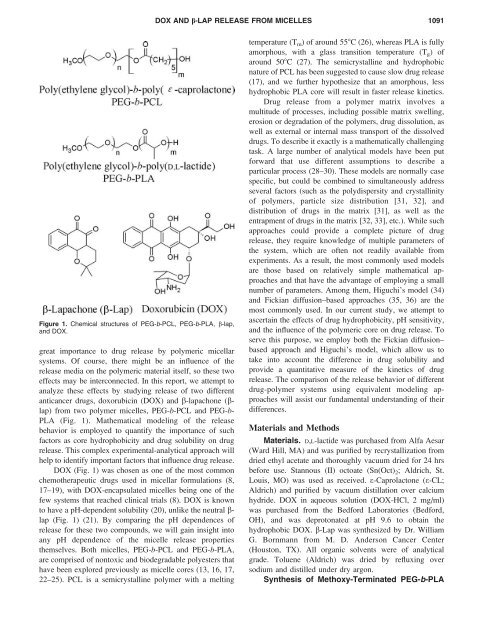Doxorubicin and b-Lapachone Release and ... - UT Southwestern
Doxorubicin and b-Lapachone Release and ... - UT Southwestern
Doxorubicin and b-Lapachone Release and ... - UT Southwestern
You also want an ePaper? Increase the reach of your titles
YUMPU automatically turns print PDFs into web optimized ePapers that Google loves.
DOX AND b-LAP RELEASE FROM MICELLES 1091<br />
Figure 1. Chemical structures of PEG-b-PCL, PEG-b-PLA, b-lap,<br />
<strong>and</strong> DOX.<br />
great importance to drug release by polymeric micellar<br />
systems. Of course, there might be an influence of the<br />
release media on the polymeric material itself, so these two<br />
effects may be interconnected. In this report, we attempt to<br />
analyze these effects by studying release of two different<br />
anticancer drugs, doxorubicin (DOX) <strong>and</strong> b-lapachone (blap)<br />
from two polymer micelles, PEG-b-PCL <strong>and</strong> PEG-b-<br />
PLA (Fig. 1). Mathematical modeling of the release<br />
behavior is employed to quantify the importance of such<br />
factors as core hydrophobicity <strong>and</strong> drug solubility on drug<br />
release. This complex experimental-analytical approach will<br />
help to identify important factors that influence drug release.<br />
DOX (Fig. 1) was chosen as one of the most common<br />
chemotherapeutic drugs used in micellar formulations (8,<br />
17–19), with DOX-encapsulated micelles being one of the<br />
few systems that reached clinical trials (8). DOX is known<br />
to have a pH-dependent solubility (20), unlike the neutral b-<br />
lap (Fig. 1) (21). By comparing the pH dependences of<br />
release for these two compounds, we will gain insight into<br />
any pH dependence of the micelle release properties<br />
themselves. Both micelles, PEG-b-PCL <strong>and</strong> PEG-b-PLA,<br />
are comprised of nontoxic <strong>and</strong> biodegradable polyesters that<br />
have been explored previously as micelle cores (13, 16, 17,<br />
22–25). PCL is a semicrystalline polymer with a melting<br />
temperature (T m ) of around 558C (26), whereas PLA is fully<br />
amorphous, with a glass transition temperature (T g ) of<br />
around 508C (27). The semicrystalline <strong>and</strong> hydrophobic<br />
nature of PCL has been suggested to cause slow drug release<br />
(17), <strong>and</strong> we further hypothesize that an amorphous, less<br />
hydrophobic PLA core will result in faster release kinetics.<br />
Drug release from a polymer matrix involves a<br />
multitude of processes, including possible matrix swelling,<br />
erosion or degradation of the polymers, drug dissolution, as<br />
well as external or internal mass transport of the dissolved<br />
drugs. To describe it exactly is a mathematically challenging<br />
task. A large number of analytical models have been put<br />
forward that use different assumptions to describe a<br />
particular process (28–30). These models are normally case<br />
specific, but could be combined to simultaneously address<br />
several factors (such as the polydispersity <strong>and</strong> crystallinity<br />
of polymers, particle size distribution [31, 32], <strong>and</strong><br />
distribution of drugs in the matrix [31], as well as the<br />
entrapment of drugs in the matrix [32, 33], etc.). While such<br />
approaches could provide a complete picture of drug<br />
release, they require knowledge of multiple parameters of<br />
the system, which are often not readily available from<br />
experiments. As a result, the most commonly used models<br />
are those based on relatively simple mathematical approaches<br />
<strong>and</strong> that have the advantage of employing a small<br />
number of parameters. Among them, Higuchi’s model (34)<br />
<strong>and</strong> Fickian diffusion–based approaches (35, 36) are the<br />
most commonly used. In our current study, we attempt to<br />
ascertain the effects of drug hydrophobicity, pH sensitivity,<br />
<strong>and</strong> the influence of the polymeric core on drug release. To<br />
serve this purpose, we employ both the Fickian diffusion–<br />
based approach <strong>and</strong> Higuchi’s model, which allow us to<br />
take into account the difference in drug solubility <strong>and</strong><br />
provide a quantitative measure of the kinetics of drug<br />
release. The comparison of the release behavior of different<br />
drug-polymer systems using equivalent modeling approaches<br />
will assist our fundamental underst<strong>and</strong>ing of their<br />
differences.<br />
Materials <strong>and</strong> Methods<br />
Materials. D,L-lactide was purchased from Alfa Aesar<br />
(Ward Hill, MA) <strong>and</strong> was purified by recrystallization from<br />
dried ethyl acetate <strong>and</strong> thoroughly vacuum dried for 24 hrs<br />
before use. Stannous (II) octoate (Sn(Oct) 2 ; Aldrich, St.<br />
Louis, MO) was used as received. e-Caprolactone (e-CL;<br />
Aldrich) <strong>and</strong> purified by vacuum distillation over calcium<br />
hydride. DOX in aqueous solution (DOX-HCl, 2 mg/ml)<br />
was purchased from the Bedford Laboratories (Bedford,<br />
OH), <strong>and</strong> was deprotonated at pH 9.6 to obtain the<br />
hydrophobic DOX. b-Lap was synthesized by Dr. William<br />
G. Bornmann from M. D. Anderson Cancer Center<br />
(Houston, TX). All organic solvents were of analytical<br />
grade. Toluene (Aldrich) was dried by refluxing over<br />
sodium <strong>and</strong> distilled under dry argon.<br />
Synthesis of Methoxy-Terminated PEG-b-PLA
















